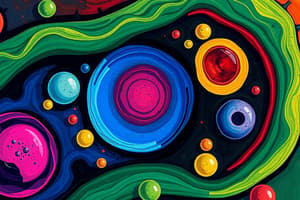Podcast
Questions and Answers
What is the primary function of the nucleus in a cell?
What is the primary function of the nucleus in a cell?
- Regulates substance movement
- Energy production
- Protein synthesis
- Contains genetic material and controls cell activities (correct)
Which type of cell is characterized by a lack of a true nucleus?
Which type of cell is characterized by a lack of a true nucleus?
- Prokaryotic cells (correct)
- Plant cells
- Animal cells
- Eukaryotic cells
Which organelle is known as the 'powerhouse of the cell'?
Which organelle is known as the 'powerhouse of the cell'?
- Golgi apparatus
- Ribosome
- Mitochondria (correct)
- Endoplasmic reticulum
What is the main role of the Golgi apparatus?
What is the main role of the Golgi apparatus?
What process allows cells to respond to environmental changes?
What process allows cells to respond to environmental changes?
Which structure acts as a semi-permeable barrier around the cell?
Which structure acts as a semi-permeable barrier around the cell?
What type of transport does not require energy to move substances across the cell membrane?
What type of transport does not require energy to move substances across the cell membrane?
Which of the following cell types contains membrane-bound organelles?
Which of the following cell types contains membrane-bound organelles?
Flashcards are hidden until you start studying
Study Notes
Cell Structure
-
Basic Unit of Life: Cells are the smallest unit of life, functioning as the building blocks for all living organisms.
-
Types of Cells:
- Prokaryotic Cells:
- Lack a nucleus (e.g., bacteria).
- Have a simpler structure, with no membrane-bound organelles.
- Eukaryotic Cells:
- Contain a nucleus and membrane-bound organelles (e.g., plant and animal cells).
- Prokaryotic Cells:
-
Common Cell Organelles:
- Nucleus:
- Contains genetic material (DNA).
- Controls cell activities.
- Mitochondria:
- Powerhouse of the cell.
- Site of ATP (energy) production through respiration.
- Ribosomes:
- Sites of protein synthesis.
- Can be free in the cytoplasm or attached to the endoplasmic reticulum.
- Endoplasmic Reticulum (ER):
- Rough ER: Studded with ribosomes, synthesizes proteins.
- Smooth ER: Synthesizes lipids and detoxifies.
- Golgi Apparatus:
- Modifies, sorts, and packages proteins and lipids for secretion or use within the cell.
- Cell Membrane:
- Semi-permeable barrier surrounding the cell.
- Regulates the movement of substances in and out of the cell.
- Cytoplasm:
- Gel-like substance where cell organelles are located.
- Site for many metabolic reactions.
- Cytoskeleton:
- Network of fibers maintaining cell shape and facilitating movement.
- Nucleus:
Cell Function
- Metabolism:
- All chemical processes that occur within cells, including energy production, synthesis of molecules, and catabolic reactions.
- Reproduction:
- Cells can reproduce through mitosis (for growth and repair) or meiosis (for gamete formation).
- Response to Stimuli:
- Cells can react to environmental changes through signaling pathways and receptor proteins.
- Transport Mechanisms:
- Passive Transport: Movement of molecules across cell membranes without energy (e.g., diffusion, osmosis).
- Active Transport: Movement of molecules against their concentration gradient, requiring energy (e.g., sodium-potassium pump).
- Cell Communication:
- Cells communicate through chemical signals, including hormones and neurotransmitters, affecting cellular responses.
- Homeostasis:
- Cells maintain a stable internal environment by regulating pH, temperature, and concentration of ions and molecules.
Cell Structure
-
Cells are the fundamental units of life, serving as the basic building blocks for all living organisms.
-
Two main types of cells exist:
- Prokaryotic Cells:
- Do not possess a nucleus and have a simpler overall structure with no membrane-bound organelles.
- Example: Bacteria.
- Eukaryotic Cells:
- Contain a distinct nucleus and various membrane-bound organelles.
- Examples: Plant and animal cells.
- Prokaryotic Cells:
-
Common organelles within cells include:
- Nucleus:
- Houses genetic material (DNA) and directs cell activities.
- Mitochondria:
- Known as the "powerhouse" of the cell, where ATP (energy) is produced during respiration.
- Ribosomes:
- Responsible for protein synthesis; can be free in the cytoplasm or attached to the endoplasmic reticulum.
- Endoplasmic Reticulum (ER):
- Rough ER: Contains ribosomes, synthesizes proteins.
- Smooth ER: Involved in lipid synthesis and detoxification processes.
- Golgi Apparatus:
- Modifies, sorts, and packages proteins and lipids for export or for use within the cell.
- Cell Membrane:
- A semi-permeable barrier that regulates the entry and exit of substances in and out of the cell.
- Cytoplasm:
- A gel-like matrix where organelles reside; a site for many metabolic reactions.
- Cytoskeleton:
- A network of fibers providing structural support and facilitating cellular movement.
- Nucleus:
Cell Function
- Metabolism:
- Encompasses all chemical reactions within cells, including energy production and the synthesis and breakdown of molecules.
- Reproduction:
- Cells can replicate through two processes:
- Mitosis for growth and tissue repair.
- Meiosis for producing gametes (sperm and eggs).
- Cells can replicate through two processes:
- Response to Stimuli:
- Cells react to environmental changes through signaling pathways and receptor proteins, which help in processing information.
- Transport Mechanisms:
- Passive Transport: Involves the movement of substances across cell membranes without using energy, such as diffusion and osmosis.
- Active Transport: Requires energy to move substances against their concentration gradient, exemplified by the sodium-potassium pump.
- Cell Communication:
- Utilizes chemical signals, such as hormones and neurotransmitters, to influence the behavior and responses of cells.
- Homeostasis:
- Cells strive to maintain a stable internal environment by regulating various factors including pH, temperature, and ion concentration.
Studying That Suits You
Use AI to generate personalized quizzes and flashcards to suit your learning preferences.




